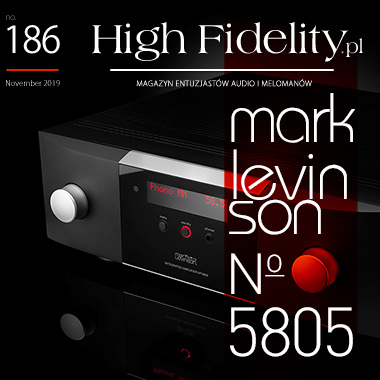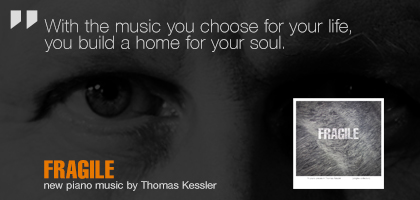No. 257 October 2025
- COVER REVIEW: ANCIENT AUDIO Silver Grand Mono Mk II ⸜ power amplifier • monoblocks » POLAND • Kraków
- KRAKOW SONIC SOCIETY № 153: 30 years of ANCIENT AUDIO » POLAND • Kraków
- FEATURE ⸜ music & technology: HISAO NATSUME presents - In search for the lost great pianism Chopin tradition » part 2 (France) » JAPAN • Tokyo
- REVIEW: AUDIOPHONIQUE Classic AP 300D ⸜ power amplifier » POLAND • Pruszków
- REVIEW: AVATAR AUDIO Holophony No. 1 ⸜ loudspeakers • floor-standing » POLAND • Osowicze
- REVIEW: DIVALDI Gold PA One ⸜ integrated amplifier » POLAND • Kraków
- REVIEW: J.SIKORA Aspire ⸜ turntable (deck + tonearm) » POLAND • Lublin
- REVIEW: MB AUDIO CABLE Silver ⸜ analog interconnect ⸜ RCA » POLAND • Turza Śląska
- REVIEW: XACT N1 ⸜ LAN switch » POLAND • Wrocław


|

|
|
OLEŚ DUO | ALONE TOGETHER

Searching for information about Marcin, I realized that we are peers, both born in 1973. Tall, handsome, with special, cat-like elegance - he is one of the most interesting double bass players on the Polish music scene. Together with their brother Bartłomiej, a drummer, they form the Oleś Duo band, but they also appear in other configurations under the name Oleś Brothers. The main area of their musical search is jazz, but they also record ethno music such as on the Sefardix with Jorgos Skoliass, from 2014. Marcin reached out to me again in February or March this year. He had a proposal for me - he wanted to talk about the technical side of the latest project - his and his brother's - which was to be released on vinyl record and it was supposed to be a REFERENCE record. As a result we met more than once. Based on several conversations, we managed to work out a kind of "common base", an agreement on which something could be built. 
Before going to the recording studio, Marcin listened to various recordings in my system to find out what a high-end audio equipment could do. Apparently the session confirmed what he'd suspected, because right after that he borrowed from me the Acoustic Revive interconnect, which he used to connect the preamplifier connected to his double bass, as well as a power cable to use with the same preamplifier. We met again in mid-September to listen to two different masters of the latest album. So herewith you're getting first-hand information about it and it's happening even before the release date of this album. I am talking to his latest album released under “High Fidelity's” patronage, with MARCIN OLEŚ. | RECORDING WOJCIECH PACUŁA: When did you start this project? We wanted to celebrate our joint activity with a new joint project that would be a solo one at the same time - this year we celebrate a 20th anniversary of the release of our first album. In 1999, I received an award at the Jazz on the Oder Festival, and with my brother as the Custom Trio, the 2nd prize at the Jazz Juniors Festival, because we had to start somehow as outsiders. This is a symbolic date for us. But it is fluid, because our first official album came out in 2000. A year earlier we released the first album that we recorded for these festivals, which we called perversely Mr. Nobody because we were nobodies from outside the environment. We released it first as a cassette, then as a CD. But it wasn't available in official distribution, that's why our official debut was actually the album recorded with Andrzej Przybielski titled Free Bop. 
Bartłomiej Oleś during recording session You got very involved in the technical side of this album - you could say "sonic" one ... It's all related also to the previous album, the Spirit of Nadir, which was met with a very positive response from the audiophiles and vinyl record lovers. So I suggested that we would raise the bar - I was curious myself how we can get the most sound quality from our instruments in the studio. That's where the idea of using some high-end electronics and audiophile accessories came from. I mean cables, microphone preamplifiers and the microphones themselves. Sveda Audio provided us with studio monitors. Thanks to your help, I could get a unique sound of my instrument - I used the Acoustic Revive interconnect and Harmonix power cable borrowed from you in the recording. 
Marcin Oleś during recording session We were able to convince many people to this project, who we will be mention in the record's insert. It also cause a double mobilization in the studio. The standard process turned into something more, into something that made everyone think of "something special." We all learned a lot during this project. From what I heard in your system we have achieved nice results :) I do not know if without this attitude the result would be equally good. We recorded in a well-equipped studio, with wonderful, old Neumann microphones, Neve preamplifiers, custom-made contemporary items – you can feel it too. But these extra elements allowed us to reach, I think, more than ever before. | RELEASE What's the title of the new album? That's also where the idea for the cover comes from, right? Due to the fact that we wanted it all to start from the cover, it will not have a back side and regardless of how you pick it up, you will always look at its front. On one side there will be a photo of one musician and the other on the other one. And the record will slide in from above, so there will also be no classic back of the cover. When we came up with this idea I didn't know that maxi-singles were released this way in the USA. This idea was proposed by Marcin Mizerek, representing the publisher, Audio Cave, who at some meeting told us he had such records that were put inside cover from the top not from the side. This is a case of a perfect timing :) A little digression - I don't know about you, but I like the B side the most on vinyl records. And it has nothing to do with the album we are talking about now :) Simply the B side was always treated more loosely, especially by jazz artists in the 1950s and 1960s - I hate their A sides, because the second track is almost always a ballad, which usually doesn't make any sense. When you listen to the sixtieth album and once again hear the same repeating pattern, you feel like you want to throw it away. That's why I always start from the B side, because it seems more authentic and less calculated to me. |
| TWO MASTERING JOBS – MARCIN AND ME :) 
The work on mixing and mastering of the Oleś brothers' record lasted a long time, much longer than usual. Although these are solo recitals, each instrument was recorded with several different microphones to help sound engineers to capture their natural sound - as Marcin says: "adequate sound". But that's why the possibilities to change the sonic character of the recording were really great. So several versions of this album were created. Ultimately, it was decided to use the one in which there was the least interference in the sound Marcin brought to me Master CD-Rs with this material and an additional disc with an alternative version. Each of the sides - and in the case of the CD version, each of the discs - has its own character, given to them during recording and then mastering by the musicians who were responsible for it. Side B, i.e. the one with the drums, has a close character, it offers primarily direct sound. On the other hand, the M side, with the double bass, sounds more "roomy", the sound of this instrument is a bit more distant. Both versions are extremely dynamic and resolving. Side B | The drum sound is exceptionally intense. One has a feeling of listening to an event happening "here and now". The dynamics is fantastic and only on the best recordings of this type, fully analog ones and immediately mixed to the stereo version, it is possible to achieve more. This is a very resolving sound, and therefore rich with information. There are plenty of details, but we do not hear them at all, they come to us all together, as a complete sound, not as individual components. It is a low, dense sound, but with strong, intense, heavy weight metal cymbals. Side M | The double bass has more air in its sound. This does not mean that it is better than or worse than percussion, but simply different. While the drum side resembles jazz recordings from the 1950s and 1960s, Marcin's side refers to Japanese recordings by Mr. Okihiko Sugano – a different aesthetics, different goals, but ultimately the class is the same. It is a double bass with very good proportions between the size and the fact that it is a reproduction played from a recording that differs from a live performance. The sound of the instrument is beautifully filled, but there is both selectivity and resolution. I wonder how it will sound on vinyl, because it is difficult to convey such high dynamics and such selectivity on a record. But I can say one thing about the Compact Disc version: it's a REFERENCE. And a great music too – some parts are contemplative, some energetic, but it's interesting form the first till the last note. What about Compact Disc – I know you were focused on vinyl record release but there will be a digit version too, right? 
When should we expect the CD release? The problem is, as usual, the visual side of the release. The WM Fono does not do these things in-house, but outsources them. Depending on who they order it from, the results are slightly different. For example, the record label has two different types of gatefolds release types, i.e. a fold-out - wide and narrow - and you never know which one you will get. The quality problem is a fundamental one in this country. We seem to keep bouncing off a wall. I'm not saying that elsewhere quality is always guaranteed, that you always get exactly what you ordered, but it is more likely to happen. And only in Japan can you realize even the craziest ideas. The Japanese are champions in this respect. | MUSIC What is most important to you in music? What you mean by sound? 
Two masterings of the new album… So that's where your interest in music comes from? Thanks to the orchestra's rehearsals, my father took me to, I learned about the proximity of the instrument - I felt the weight. I was immersed in the sound of acoustic instruments played very close. So when I listen to music using audio equipment, I am looking for that. I am looking for this proportion, this dynamics, I like something I heard in your system on the Takeshi Inomata album (The Dialogue, Audio Lab. Record from 1977 - ed.) - it was IT! It sounds like something that is actually there. Who is you new album intended for? Interestingly, the Bartek's side, i.e. B side, is more prepared, thought out, and mine, i.e. the M side, is more improvised. I improvised, because I heard differently a recording with this quality of sound - these miniatures are called "lapidaries". They are based on a sketch, have an open form, but were closed by the recording process itself. 
And where did the idea to be more „audiophile” came from? Did you succeed? Thank you and see you at the Audio Video Show! |
About Us |
We cooperate |
Patrons |
|
Our reviewers regularly contribute to “Enjoy the Music.com”, “Positive-Feedback.com”, “HiFiStatement.net” and “Hi-Fi Choice & Home Cinema. Edycja Polska” . "High Fidelity" is a monthly magazine dedicated to high quality sound. It has been published since May 1st, 2004. Up until October 2008, the magazine was called "High Fidelity OnLine", but since November 2008 it has been registered under the new title. "High Fidelity" is an online magazine, i.e. it is only published on the web. For the last few years it has been published both in Polish and in English. Thanks to our English section, the magazine has now a worldwide reach - statistics show that we have readers from almost every country in the world. Once a year, we prepare a printed edition of one of reviews published online. This unique, limited collector's edition is given to the visitors of the Audio Show in Warsaw, Poland, held in November of each year. For years, "High Fidelity" has been cooperating with other audio magazines, including “Enjoy the Music.com” and “Positive-Feedback.com” in the U.S. and “HiFiStatement.net” in Germany. Our reviews have also been published by “6moons.com”. You can contact any of our contributors by clicking his email address on our CONTACT page. |
 



|
   |
main page | archive | contact | kts
© 2009 HighFidelity, design by PikselStudio,
projektowanie stron www: Indecity







 t all started ... really started about ten years ago, if not before. At the time, an email came to the "High Fidelity" mailbox, a standard one, asking for advice. MARCIN wrote to me asking for recommendation for a subwoofer at a reasonable price. He explained that he was a musician, double bass player, who was looking for a subwoofer for his music system. I answered to the best of my abilities and it probably made some sense, because after some time the same man sent thank you and asked for my home address and later he sent his last two albums recorded by him and his brother. The name was: OLEŚ.
t all started ... really started about ten years ago, if not before. At the time, an email came to the "High Fidelity" mailbox, a standard one, asking for advice. MARCIN wrote to me asking for recommendation for a subwoofer at a reasonable price. He explained that he was a musician, double bass player, who was looking for a subwoofer for his music system. I answered to the best of my abilities and it probably made some sense, because after some time the same man sent thank you and asked for my home address and later he sent his last two albums recorded by him and his brother. The name was: OLEŚ. 


